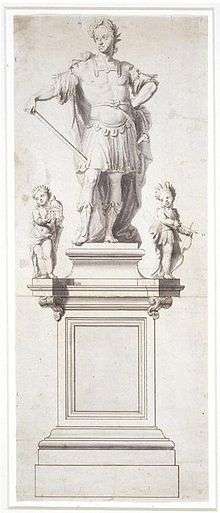John Nost

John Nost[1] (died 1729) was a Flemish sculptor who worked in England in the late 17th and early 18th centuries.
Life
Originally from Mechelen in Belgium, he moved across the North Sea to work in England in the second half of the 17th century, gaining employed with the sculptor Arnold Quellin as a foreman. After Quellin's death in 1686 Nost married his widow, and established his own sculptural works business in the Haymarket district of London.
He was prolific and received many commissions, including employment at Hampton Court Palace, Melbourne Hall, Castle Howard, Buckingham Palace and Chatsworth. Many of his statues were in cast lead.
Van Nost died at his home at Hyde Park in London on 26 April 1729.
Sculptors apprenticed to Van Nost
Van Nost trained Andrew Carpenter, and his own nephew John van Nost the younger, his nephew carried on the family business following his uncle's death.
Notable works
Source[2]

- Statue of Sir Hugh Wyndham (judge) at Silton, Dorset (1692)
- Figures of a Boy and Girl, Chatsworth House (1698)
- Monument to John Digby, 3rd Earl of Bristol, Sherborne, Dorset (1698)
- Pair of amorini, Melbourne Hall (1699) for his patron, Thomas Coke
- Fireplace for Thomas Coke's London house on St James Place (1699)
- Various mythological figures for the gardens of Melbourne Hall (1700)
- Coat of Arms on entrance piers, fireplaces and marble tables, Hampton Court (1700)
- Flower Pot Gates, Hampton Court (1700)
- Statues of King William III and Queen Mary, Royal Exchange, London, (c.1700)
- Fountains at Hampton Court (1701–2)
- Multiple fireplaces for Melbourne Hall (1701–7)
- The Crouching Venus, Umberslade Hall (1702)
- Multiple garden figures for Castle Howard (1703–10)
- Statues within the pediment of Buckingham Palace (1705)
- Vase of the Seasons, Melbourne Hall (1705)
- Fountains and figures for Stoneyhurst House (1705–1716)
- Monument to James Douglas, 2nd Duke of Queensberry, Durisdeer Church, Dumfriesshire (1711)
- Garden figures, Stourhead House (c.1714)
- Garden figures for Moulsham Hall (1717) (for Humphrey Mildmay)
- Statue of George I for Essex Bridge, Dublin (1717) (later moved to Barber Institute of Fine Arts, Birmingham)
- Garden figures for Rousham House (c.1719)
- Statue of Queen Mary for University College, Oxford (1720)
- Garden figures for Seaton Delaval Hall (c.1720)
- Garden figures for Chirk Castle (c.1720)
- Statue of Sir Robert Geffrye for the almshouses at Shoreditch (1723) (original now at Mottingham with a replica at the almshouses)
- Statue of George II for Cannons House (c.1724) (moved in 1753 to create a centre-piece for Golden Square in London)
- Two large vases for Wrest Park (1725) for the Duke of Kent
- Statue of George I for Grosvenor Square, London (1726) (stolen 1838)
- Garden figures for Boreham House (c.1728)
Notes
References
- Rupert Gunnis, Dictionary of British Sculptors 1660–1851 (1968 revised edition), pp. 279–282